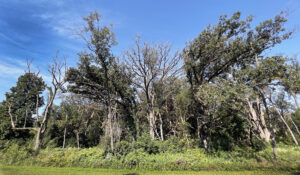By Michael Hillstrom, Forest Health Specialist, Fitchburg
Michael.Hillstrom@wisconsin.gov

Oak decline at Big Foot Beach State Park caused by flooding, drought, spongy moth defoliation, twolined chestnut borer and Armillaria. / Photo Credit: Michael Hillstrom, Wisconsin DNR
Bur and white oaks, most of them more than 100 years old, have experienced rapid mortality (within one to two years) over the past four years in southern Wisconsin and neighboring states. Research into the cause is ongoing, but the evidence so far suggests it’s an oak decline.
Oak declines are not caused by a single issue, but rather by the stacking of multiple health issues. Drought, flooding, storm damage, age, twolined chestnut borer, Armillaria and other root pathogens, and spongy moth and oak leafroller defoliation all play a role in the damage.
Oak wilt is not a part of this decline. Generally, damage is scattered throughout a stand with healthy oaks remaining.
Management is difficult because the main drivers are weather, age and the native insects and pathogens taking advantage of the stress. Hopefully, the consistent rain this spring and summer will help get the oaks in better health and able to fight off the insects and fungi.
For additional details, check out the management section of the Minnesota Forest Health Team’s new webpage about oak decline.
